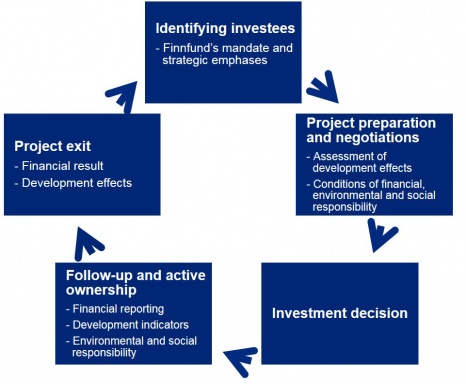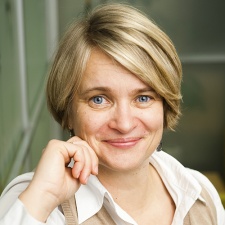Investing in private projects
The terms on which we provide finance are market-based and depend on overall project risk. Along with long-term investment loans, we make equity-rated investments and offer customers subordinated loans or other mezzanine financing. Some of our investments are for expanding existing activities, others for establishing entirely new operations. Whatever the form of financing, we always participate with a minority stake; Finnfund does not seek a dominant position in the companies it finances
Investment projects are assessed not merely for profitability but also for how they promote economic and social advance in developing countries. Projects that meet the conditions of the Finnfund Act and are in accordance with company strategy can be accepted for project preparation. The initial stage of this process contains an examination of whether the project meets the company’s policy on environmental and social responsibility, including the standards of the International Finance Corporation, which specialises in World Bank private sector financing. The assessment of environmental and social responsibility also helps to set the financing terms to be negotiated with customers.
Finnfund expects good corporate citizenship from the companies it invests in, and does not condone corruption, tax evasion or money laundering in its projects. Environmental matters and working conditions are two of the issues that must meet international standards even if local legislation is less stringent or entirely absent.

Finance for diverse development support
Viable enterprises are a precondition for sustainable growth and development. Profitable companies create jobs and generate tax revenues used by public sector for its operations. Tax revenues also reduce the dependence of the country on external aid. Private sector entities creates export earnings and offer consumers cheaper or better services and products. Well-managed companies also safeguard the environment by operating responsibly and using resources efficiently.
Foreign direct investment (FDI) in companies of developing countries has increased in recent years, but it has been spread unevenly. Investing especially in the poorest countries, has been regarded as too risky. The slow growth of global economy and declining prices of raw materials - crucial to developing economies’ export industries - have exacerbated the situation. In many low-income countries, companies suffer from a shortage of long-term, reasonably priced, risk-tolerant funding. Finance from Finnfund alleviates these market failures.
In addition to providing finance, Finnfund catalyses the skills and knowledge of Finnish companies to developing countries. In 2015, 11 new financing decisions were made on projects with participation of Finnish companies.
”Finnfund's hydro, solar and wind power projects produce clean power, electricity and lightning for poor households in developing countries.”
- Helena Teppana, Senior Investment Manager - Forestry, environment and renewable energy

Finnfund is especially oriented towards cooperating with Finnish companies that have solutions to the pressing problems of the developing world, and so also have opportunities in growth markets. These opportunities are often related to clean technology. Finnfund prioritises companies and projects that are large enough to succeed but too small to partner with international development banks.
Examples of cooperation with Finnish companies can be found in the investment list of the annual report.
Finnfund also provides finance for companies of developing countries with involvement of Finnish companies as technology suppliers, operators, designers or customers. In the poorest countries, especially in Africa, Finnfund can additionally finance local companies indirectly, via private equity funds and financial institutions.
Jobs and tax revenues through investments
Each year Finnfund gathers information on the development effects of its portfolio companies. This information is compiled with cross-sectoral indicators (such as jobs and government revenues) and sector specific indicators where relevant (for example power production, micro- and SME loans) for all Finnfund portfolio projects. The raw data comes from customers themselves so summary reports are subject to a small lag while it is being checked. At the end of 2014, for example, companies financed by Finnfund directly employed some 24,870 people, about 35 percent of them women (8,600).
Various payments to government paid by companies financed directly and indirectly by Finnfund totalled about EUR 277 million in 20141). Of this amount direct investments totalled EUR 80 million, financial and leasing companies EUR 44 million and funds investee companies EUR 149 million euros. Most of these were paid by investees of the private equity funds in which Finnfund has invested in Africa. Of all payments to government paid by Finnfund’s direct and indirect investee companies income taxes totalled 31 per cent, approximately EUR 86 million euros.
Tax revenues to target countries in 2014 (total EUR 277 million)
| Africa | Asia | Eastern Europe | Latin America | The Mediterranean | |
| Direct investments | 22.50 | 40.02 | 13.04 | 4,19 | 4,26 |
| Financial institutions | 27.19 | 5.21 | 11.76 | ||
| Private equity funds | 62.90 | 26.47 | 0.60 | 59.17 |
Companies financed directly by Finnfund delivered 490 GWh of electricity in 2014. Among other effects are loans to microenterprises (about 2,390,000 million loans totalling EUR 940 million) and to small and medium-sized companies (about 152,860 loans totalling EUR 2,786 million) and housing loans (about 4,334 loans totalling EUR 298 million) by companies financed directly or indirectly by Finnfund. In addition, the companies financed by Finnfund reported reaching 13,475 farmers as e.g. suppliers, buyers or subcontractors for the projects. Many projects also have voluntary programs for developing the surrounding communities and their livelihoods.
Project portfolio by region and sector
At the end of 2015 Finnfund’s portfolio contained 160 projects. About three-quarters of these, measured both by the number of projects and their value, were in low-income and lower-middle-income countries, which is a good achievement for Finnfund’s development policy mission. Most co-investment with Finnish companies was in middle-income developing countries such as India, China and Ukraine, and also in Russia. In low-income countries, Finnfund largely finances infrastructure, and usually jointly with other development finance institutions, but even these projects generally have an involvement by Finnish companies as technology suppliers.
There were 101 direct investments and 59 investments via private equity funds and financial institutions. Finnfund’s direct investments are spread over many sectors, from engineering workshops to forest plantations, and from pharmaceuticals to power generation. About 45 per cent of investment decisions and about half of total investments in euros made in 2015 can be classed as climate-related because they produce renewable power, prevent deforestation, save energy and raw materials, or improve the adaptability of poor people to the challenges of climate change.
1) This is the total of all payments to government paid by the companies financed. There is no technically reliable way to isolate the proportion attributable to financing from Finnfund.

